Free Email Bounce Rate Calculator
Need to know the email bounce rate for your campaign or newsletter? Try our free email bounce rate calculator and find yours in seconds.
Try it now ➔
What is email bounce rate?
Email bounce rate describes the percentage of your emails that go undelivered when publishing a campaign or newsletter. You can calculate email bounce rate using the following formula:
Number of undelivered emails / Number of total emails sent = email bounce rate
Email bounces may occur for several reasons, which is why we separate email bounces into two categories.
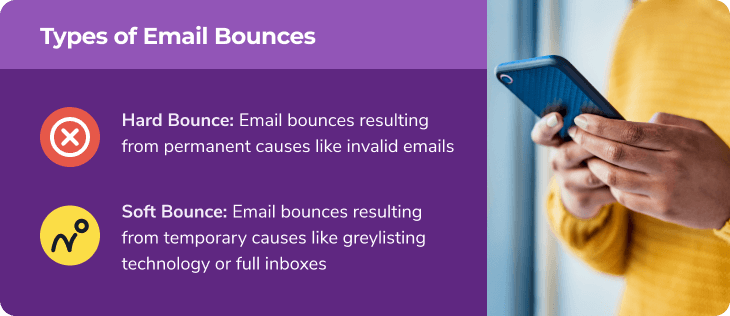
- Hard bounce - Unsuccessful delivery resulting from permanent causes like an invalid email address
- Soft bounce - Unsuccessful delivery resulting from temporary causes such as greylisting technology or a full inbox
Hard bounces are what people typically refer to when discussing email bounce rates as they are the most detrimental to your email deliverability. A high hard bounce rate directly indicates email list health issues.
Soft bounces are not ideal, but you can generally resolve them after identifying the temporary problem. Your email service provider (ESP) can also tell the difference between the two bounce types and weigh them against you accordingly.
What is an acceptable bounce rate?
Email bounce rate is a serious concern for any email marketer. A hard bounce rate that’s too high can significantly impact your email deliverability rates.
Regardless of industry, you should strive to keep your average email bounce rate below 2%. This is the acceptable rate established by internet service providers (ISPs) to help distinguish quality email content from spam.
ESPs enforce this email bounce rate standard. If you continue to bounce more messages than allowed, you can expect an email bounce warning on your account.
Average bounce rates by industry
According to a HubSpot study, the industry average bounce rate for email is about 0.63%. Bounce rate doesn’t fluctuate like email open rate or other email marketing metrics. Instead, most industries successfully keep their email bounce rate below 1% due to its importance.
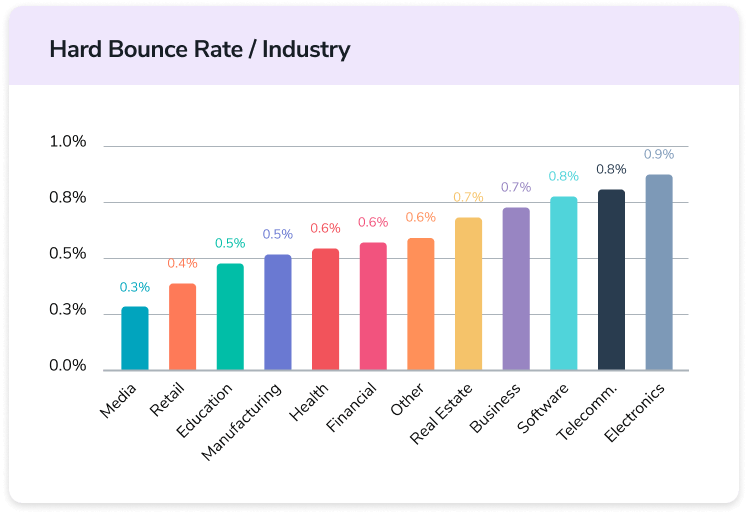
Regardless of your industry, keeping your hard bounce rate low is vital to successful email marketing. Source: HubSpot
Reading your email bounce rate results
After entering your data, the email bounce rate calculator will provide your bounce rate. Your results will fall into one of three categories.
- 2% or lower - This is a reasonable bounce rate
- 2.1% - 5% - Your bounce rate is higher than usual
- 5.1% or higher - Your email list needs your attention. Your bounce rate is at a dangerous level.
Use these results to help you with your email list hygiene. If your email bounce rate exceeds the accepted average of 2%, try using ZeroBounce’s email validation service to eliminate invalid email addresses.
Email validation can further reduce your number of undelivered messages or bring the count to zero, even if you are someone within a safe bounce rate threshold.

Getting rid of invalid email addresses is the best way to reduce or eliminate hard bounces.
What causes high email bounce rates?
Now that you know the bounce rate for your email campaign or newsletter, let’s look at the various factors that can lead to undelivered emails.
Invalid emails will make you exceed the email bounce rate benchmark
Invalid emails are by far the most significant contributor to high email bounce rates. Your ESP can’t deliver the message if the address does not exist. This would lead to a hard bounce.
You can accumulate invalid emails on your list through several means, including
- Human input error - ZeroBounce prevented more than 10 million potential email bounces by correcting typos on signup forms in 2022. Misspellings and incorrect domains also result from input errors.
- Buying email lists - When you buy your email data, there’s no telling if the addresses are quality. While we can’t suggest buying lists, be sure to verify any contact that you acquire.
- Disposable emails - Temporary addresses can become invalid in just five minutes. By the time you get your next campaign ready, it’s already invalid.
- No longer in use - Sometimes, once-quality emails go invalid when they’re no longer in use. People change addresses, acquire new roles, or switch companies, which leads to abandoning the old email address on your list.
Anti-spam technology can cause soft bounces for email
Though not as severe as a hard bounce, anti-spam technology such as greylisting can cause your emails to bounce temporarily.
Most anti-spam efforts are time-based. You’ll need to configure your Simple Mail Transfer Protocol (SMTP) options to re-attempt delivery after a period, usually fifteen minutes. Rather than bounce back, you will successfully reach the inbox after the greylisting period elapses.
Alternatively, you can request the receiving domain to whitelist your domain or IP to bypass this spam prevention tactic.
Full inboxes can impact your email marketing bounce rate
Email inboxes have a storage limit. The maximum size of the inbox varies depending on the service and the user's plan. If an inbox is full, it can’t receive additional emails.
Fortunately, a full inbox response leads to a soft bounce. You can re-attempt delivery later after the recipient has had a chance to make room. If you notice continued bounces and zero engagement, consider removing that address from your list, as the inbox may be abandoned.
How email bounce rate impacts email deliverability rates
A high hard bounce rate has negative consequences that extend beyond a failed delivery attempt.
ISPs associate high bounce rates with spammers. If you consistently demonstrate a bounce rate above 2%, you can expect more ISPs to question your emails, even if you’re a genuine sender.
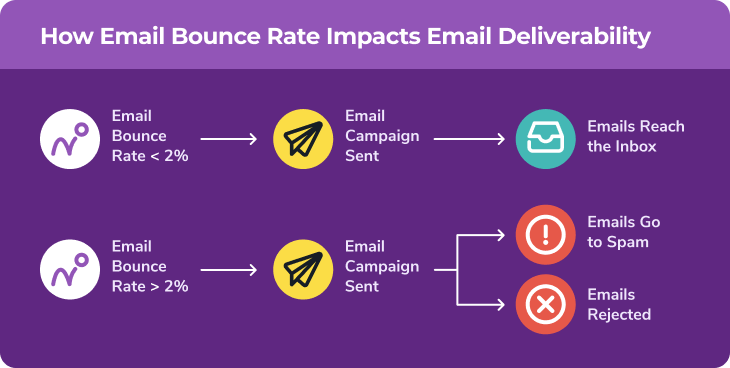
Instead of reaching the inbox, your email contacts may stop seeing your emails in their inbox but instead in their spam folder. Reaching a spam folder technically counts as “delivered,” but doing so will impact open and click rates. Readers aren’t likely to trust content marked as spam.
Depending on how strict the recipient server’s anti-spam tactics are, it may reject emails from your domain entirely. This makes it impossible to reach those valid contacts until you can restore your sender reputation.
How to use email bounce rate to guide your email marketing
You can’t afford to hard bounce emails.
If your email campaigns or newsletters consistently show a bounce rate that exceeds the 2% threshold, use the metric to guide you toward the following actions.
Maintain a consistent email delivery schedule to avoid mass bounces
Occasional bounces will happen.
However, you can keep your email bounce rate under the suggested standard by consistently sending email messages on a predictable schedule.
After you send out your next email campaign or newsletter, monitor important email marketing metrics like open rates, clicks and bounces. If you investigate the cause of those bounces and find that some of your email addresses are no longer valid, you can delete them from your email list.
On the other hand, sending out email campaigns sporadically increases the likelihood of emailing more invalid addresses. Stay consistent and maintain your email list hygiene to keep that bounce rate low.
Double-check your email server configuration
A well-configured email server should be able to identify the cause of a bounce and reattempt delivery when possible.
Email service providers should provide this feature by default. Anti-spam technology is commonplace, and genuine email users must be able to reach new contacts reliably. However, you may have an issue with your email server configuration that makes this less likely.
Take advantage of email server testing tools to identify problems with your current setup.
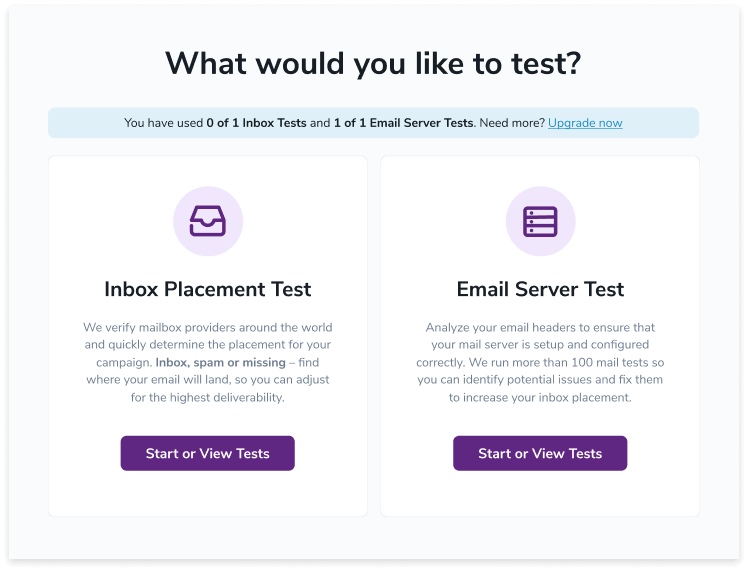
ZeroBounce offers free users one free email server test monthly to help keep your email bounce rate low.
Authenticate your domain to help keep your average email bounce rate low
Email authentication is a strategy that allows ISPs to determine if an email message is from a legitimate, authorized sender from the associated domain.
Among these email authentication methods are
- Sender Policy Framework (SPF)
- Domain Keys Identified Mail (DKIM)
- Domain-Based Message Authentication, Reporting and Conformance (DMARC)
Creating and implementing these email authentication records helps prove your legitimacy and can reduce how often you bounce emails.
Require double opt-ins for email subscriptions
Double opt-ins are commonplace for email registration as it ensures the email is valid. It works like this:
- 1. A user signs up on your registration form using their email address.
- 2. You automatically send a confirmation email to the address. The user verifies that they want to receive email correspondence.
- 3. You receive confirmation that the address is valid and that you can safely send emails without fear of a bounce.
Without a double opt-in, anyone can enter a fake email address into the signup field, and you won’t know it’s invalid until an email bounces.
Email validation is the best way to reduce or eliminate email bounces
The primary cause of a bounced email is an invalid email address. An email validation service will quickly scrub your email list of all invalid addresses.
Barring special circumstances, like those that lead to soft bounces, your email bounce rate should lower to 0 after using an email validator.
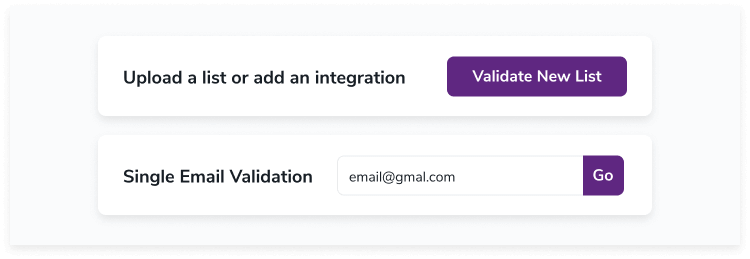
ZeroBounce allows you to upload your entire email list or validate email addresses one at a time.
Just export your email list from your service provider, upload it to ZeroBounce, clean the list, and import your results back into your preferred platform.
Verify emails in real time with an API
While you should clean your email list with an email validator once a quarter, invalid addresses can creep back onto your list.
The ZeroBounce email validation API helps with that.
After you create your free account, you’ll receive a unique API key, allowing you to install our email validator on your website, landing pages and wherever you collect emails. If we detect an invalid or high-risk email, we’ll block it from entering your email list.
The best way to lower your email bounce rate is to stop invalid addresses from entering your list in the first place.
Try these free email deliverability calculators
Frequently asked questions
Email bounce rate is the percentage of undelivered emails versus the total number of emails sent in a campaign or newsletter. You can calculate email bounce rate with this formula:
Bounced emails / total emails sent = email bounce rate
The average email bounce rate is just under 1%. Everyday email users typically send to addresses they’re familiar with, while companies tend to be proactive about scrubbing bad data from an email marketing list. That said, 2% is considered the industry benchmark for a safe email bounce rate.
Anything higher than a 2% email bounce rate is high. A bounce rate of 20% is dangerous and will lead to email deliverability problems and a potential suspension of your email service account. Remedy the issues leading to your high email bounces to avoid future complications.
Poor email list hygiene is the primary cause of a high email bounce rate. Specifically, a high number of invalid email addresses will result in higher bounces.
Other factors can lead to soft bounces, such as anti-spam technology, improper email server configuration or an overloaded email inbox.
To reduce your email bounce rate, implement the following tactics:
• Clean your email list at least once a quarter (every three months)
• Use a real-time email verification API
• Authenticate your email domain
• Check your email server configuration
• Use double opt-ins
• Maintain a consistent email schedule
